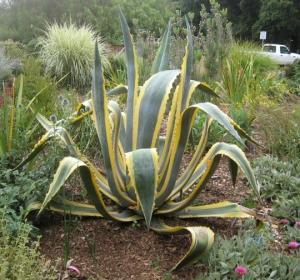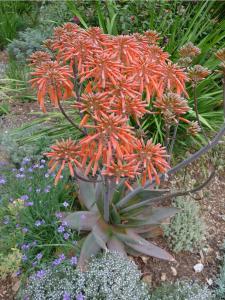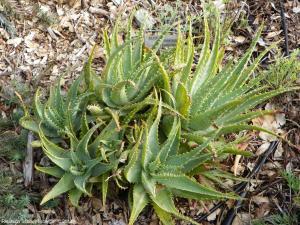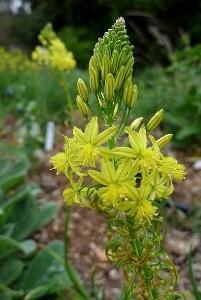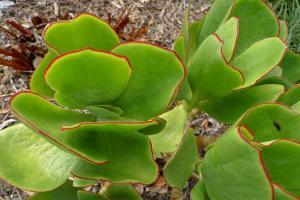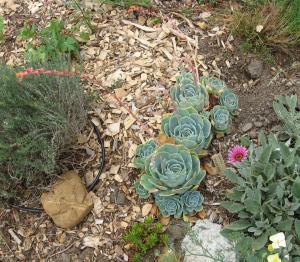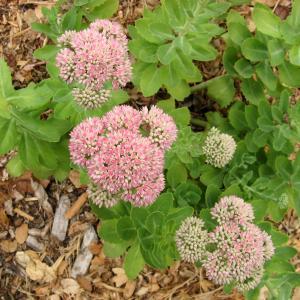Water Wise Plants
Here's a full list of all our water wise plants. You can also view an image gallery, or view the plants by categories.
Agave americana
Pronunciation
ah-GAH-vay ah-mer-ih-KAY-nah
Common Name
Century Plant
Plant Type
Succulent
Mature Size
6 ft. wide to 10 ft. high
Water Requirements
Low: water every three weeks until the root ball is wet
Sun/Shade Requirements
Full to half sun
Wildlife
Flower Color
Yellowish green flowers on 15 ft. to 20 ft. stalks
Where to See
Maintenance- Design- Planting Tips
This plant is quite the showstopper and makes a powerful statement when placed among grasses and softer, small-leaved perennials. Small plants form around the base of the plant, but they are easily pruned out if desired.
PADG notes: To prevent accidental injuries, we prune off the sharp spiky tips of this plant. |
Aloe striata
Pronunciation
AL-oh stree-AH-tuh
Common Name
Coral Aloe
Plant Type
Succulent
Mature Size
2 ft. to 3 ft. tall and 1 ft. to 2 ft. wide
Water Requirements
Low: water every three weeks until the root ball is wet
Sun/Shade Requirements
Full sun
Wildlife
Flower Color
Red-orange
Where to See
Maintenance- Design- Planting Tips
Like many succulents, Aloes are from South Africa. Aloe striata tolerates cold better than most aloes and grows successfully in the Bay Area. The large, broad, fleshy leaves and tall clusters of flowers are bold additions to the summer-dry perennial bed. As a bonus, hummingbirds and bees are attracted to its orange-red blossoms.
The only maintenance this plant needs is to cut back the inflorescence after the flowers have dropped off. Aloe striata is also easy to propagate. Remove the pups (baby plants) from the base of the plant, let the stems dry and harden, and then plant the cuttings in a pot of cactus soil mix. |
Aloe x spinosissima
Pronunciation
AL-oh spin-oh-Siss-e-ma
Common Name
Spider Aloe
Plant Type
Succulent
Mature Size
2-3 ft. high, 2-4 ft. wide
Water Requirements
Very Low: water deeply several times a summer
Sun/Shade Requirements
Full to half sun, shade
Wildlife
Flower Color
Red-orange
Where to See
Maintenance- Design- Planting Tips
Spider aloe is a slow-growing succulent, making it unlikely to outgrow its space or crowd its neighbors. This low-maintenance plant is an excellent specimen for a small low-water garden.
It’s a striking plant with an interesting form – it almost looks like a piece of modern sculpture. Spider aloe is frost-tender so be sure to protect it on cold winter nights. PADG notes: In the winter, spider aloe is rumored to have red flower spikes that are attractive to hummingbirds. Unfortunately, this cannot be confirmed because the plant has never bloomed in our location. |
Bulbine frutescens
Pronunciation
BUL-bin-ee froo-TESS-enz
Common Name
Bulbine frutescens
Plant Type
Succulent
Mature Size
1 ft. high and 2 ft. to 3 ft. wide
Water Requirements
Low: water every three weeks until the root ball is wet
Sun/Shade Requirements
Full to half sun
Wildlife
Flower Color
Yellow
Where to See
Maintenance- Design- Planting Tips
This South African native is a great plant to mix into a low water flower border. It is evergreen, has spikes of star-shaped yellow or orange flowers and cool fleshy pencil-shaped leaves. The yellow-flowered Bulbine frutescens blooms mostly in the winter when very few plants are in flower. The cultivars ‘Hallmark’ and ‘Tiny Tangerine’ are more compact, have orange flowers, and bloom in the summer. Though the plant looks best when watered several times a summer, bulbine can survive on less water. When bulbine starts to flop open in the center, it is time to dig up and start fresh by planting a piece of the original plant. Cuttings will grow without much special treatment: stick them in the ground and wait for a new plant. The best time to start a new plant is during the rainy season. |
Cotyledon orbiculata var. oblonga ‘Macrantha’
Pronunciation
kot-EE-lee-don Or-bee-kul-AY-tuh
Common Name
Pig's Ear
Plant Type
Succulent
Mature Size
3 ft. tall and 2 ft. wide
Water Requirements
Low: water every three weeks until the root ball is wet
Sun/Shade Requirements
Full to half sun, shade
Wildlife
Flower Color
No flowers
Where to See
Maintenance- Design- Planting Tips
Cotyledon orbiculata has large, bright green, red-edged leaves. Many summer-dry plants have small, fine leaves so these brightly colored, fleshy leaves add a much needed punch to the garden. This is especially important during the quiet months in the fall and winter when not much is blooming.
Like many succulents, Cotyledon orbiculata is easily propagated from cuttings and does well in containers. It is cold hardy to 20–25°F. |
Echeveria sp.
Pronunciation
ech-eh-ver-EE-a
Common Name
Plant Type
Succulent
Mature Size
Less that 1 ft. tall and wide
Water Requirements
Low: water every three weeks until the root ball is wet
Sun/Shade Requirements
Half sun to shade
Wildlife
Flower Color
Pink, red with yellow tips
Where to See
Maintenance- Design- Planting Tips
Echeveria is a good filler or edging plant for the summer-dry flower border and also does well in pots. The sculptural quality of the fleshy leaves provides a nice contrast to the more delicate leaves of many perennials.
Echeverias are sometimes called ‘Hen and Chicks’, but so are Sempervivums, another succulent. It's one of the problems with using common names. In this case, it is better to use the botanical name, Echeveria. PADG Notes: Echeveria ‘Imbricata’, a UC Davis Arboretum All-Star, is featured in the Demonstration Garden. Some Echeverias do well in full sun, but Imbricata seems to do better in half shade and with a drip very close to the roots. |
Sedum 'Autumn Joy'
Pronunciation
SEE-dum
Common Name
Stonecrop 'Autumn Joy'
Plant Type
Succulent
Mature Size
1 - 2 ft. high and 2 ft. wide
Water Requirements
Low: water every three weeks until the root ball is wet
Sun/Shade Requirements
Full to half sun
Wildlife
Flower Color
Pink
Where to See
Maintenance- Design- Planting Tips
Sedum 'Autumn Joy' stands upright with no need for extra support, needs very little water and generally is not bothered by garden insects. In late summer, strong pink flowers bloom and slowly fade to a rust color. This plant is good for adding color to the garden when most other plants are tired and resting. During the winter months 'Autumn Joy' dies back to the ground and returns in the early spring.
PADG Notes: In the demonstration garden, Sedum 'Autumn Joy' is planted in a very rocky, well drained spot. It has grown very slowly, but steadily. It is a favorite of many gardeners because of the long-lasting fall color. |







